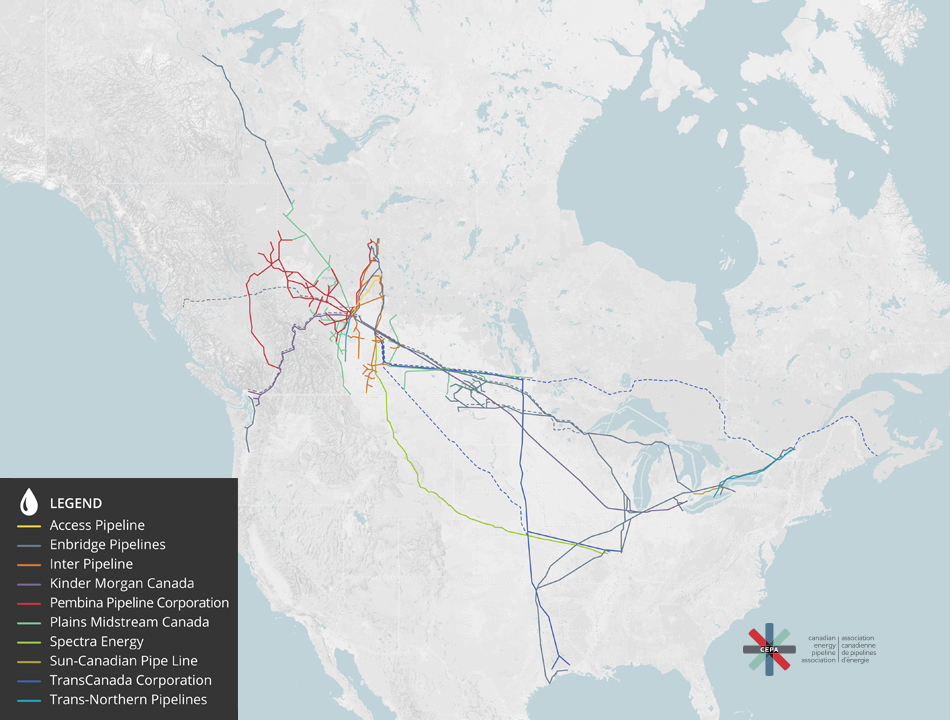Pipeline paradox
With refinery capacity in the East and abundant crude oil supplies in the West, Canada is ready for new pipeline infrastructure that connects the two regions and delivers greater economic benefits for all Canadians.
Bridging an energy-infrastructure divide
Amid lively and ongoing debate about new energy pipelines in Canada, it’s worth noting that pipelines have been helping to fuel our country since the 19th century. The first natural gas line was built more than ten years before Confederation; the first oil pipeline was completed in 1862 to transport crude from the Petrolia oilfields to a refinery at Sarnia, Ontario.
“We are a nation of pipelines,” says Chris Bloomer, President and CEO of the Canadian Energy Pipeline Association (CEPA). “Canada’s economic engine was developed around the ability to move energy trans-continentally.”
The 1950s marked the greatest period of pipeline expansion, which was critical to develop domestic and international markets for our energy products and grow the Canadian economy. According to Bloomer, we’ve developed a world-class energy business in the process and must now focus on accessing additional markets if we are to continue to realize the value of our resources.
“The key benefit to new west-to-east pipelines is that they will bring Canadian oil to Canadian refineries,” says Bloomer. The pipelines will bridge a gaping energy-infrastructure divide. Western Canada produces the bulk of Canada’s oil, with production on the rise and expected to double by 2030. Existing pipeline infrastructure is at capacity, creating supply bottlenecks. Meanwhile, Quebec and Atlantic Canada are home to a quarter of our refining capacity, yet have limited pipeline connection to the West. These refineries rely mainly on imported oil. An increasing amount of this oil has been sourced recently by rail from Texas, North Dakota and Wyoming, but some must be shipped by tanker from halfway around the world. Hence the paradox: the lack of market access means western crude oil producers must sell their oil at a discount while eastern refiners pay premiums for foreign crude.
Two pipelines in particular will lead to value creation on both sides of the country. Enbridge’s Line 9 route between Sarnia, Ontario and Montreal is actually not new. The company has reversed the flow of an existing, underutilized pipeline to enable western Canadian crude oil to move east to Quebec refineries. With National Energy Board (NEB) approval, the reversed line has been transporting Canadian crude since late 2015. However, in March 2016, the Supreme Court granted leave to appeal the NEB’s approval to the Chippewas of the Thames First Nation near St. Thomas, Ontario, creating some questions over the future of the Line 9 reversal.
TransCanada’s proposed Energy East Pipeline project will run between Hardisty, Alberta and Saint John, New Brunswick. The line will include approximately 3,000 km of converted natural gas infrastructure and 1,600 km of new pipeline. Energy East will further increase the volume of western Canadian crude available to Suncor Energy and Valero refineries in Quebec. The line will also provide access to domestic crude for Canada’s largest refinery, the Irving Oil facility in New Brunswick. The Energy East proposal is now being evaluated by the NEB.“We are a nation of pipelines,” says Chris Bloomer, President and CEO of the Canadian Energy Pipeline Association.
Canada’s economic engine was developed around the ability to move energy trans-continentally.

CEPA members operate the major Canadian oil pipelines that stretch more than 100,000 km throughout Canada and the U.S. This massive and carefully designed infrastructure is essential to the distribution of oil in North America, the health of our economy, and the stability of our standard of living. (Dotted lines indicate proposed pipelines.) Graphic courtesy Canadian Energy Pipeline Association © 2016
Safety first
The pipeline industry’s impressive safety record is one of the reasons it has remained the best option for distributing oil and gas, ahead of rail and truck transport.
“Pipeline safety is as much a concern for our industry as it is for the Canadian public,” says Bloomer. CEPA’s prioritization of safety is perhaps best exemplified in the organization’s Integrity First program. The program brings CEPA members together to go beyond regulation and make ongoing, industry-wide improvements in pipeline safety, environmental protection and socio-economic practices such as building strong relationships with landowners and Aboriginal peoples.
“It’s a condition of membership that companies must meet the program’s rigorous performance standards,” says Bloomer.
A win-win for western producers and eastern refiners
According to the Montreal Economic Institute, a pipeline network to eastern Canada will protect refineries from possible supply disruptions in politically unstable countries. Access to western Canadian crude oil can help improve competitiveness at eastern refineries by providing a greater selection of oil options and more choice related to oil availability, grade and price. An assured supply and wider price selection could also trigger investments in new technologies that would enable refineries in the East to process some heavier Canadian crude.
In the West, oil producers would benefit from access to new customers and gain better value for their oil.
In short, the pipelines can provide refineries in eastern Canada with long-term stability, and oil producers in western Canada with a valuable and secure new market.
“The world needs Canada’s oil,” says CEPA’s Chris Bloomer, “and Canada needs the economic activity associated with the safe and efficient flow of it.”
